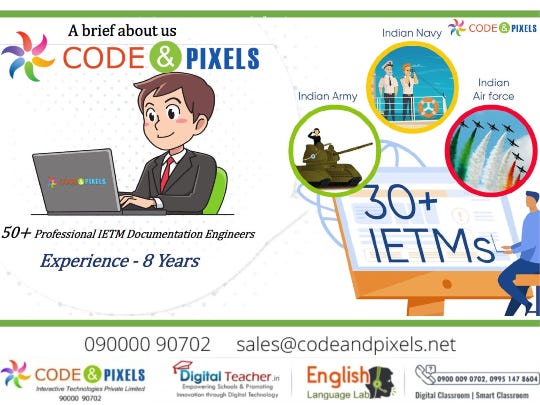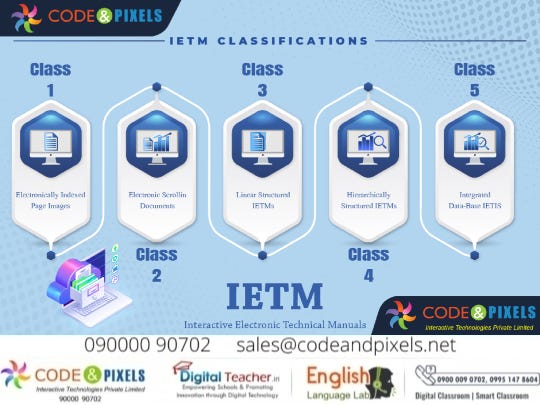Exploring Levels and Benefits of IETM: Technical Documentation
Explore the levels of IETM Viewer software, and Indian standard for IETMs, programming skills needed, and the importance in defense systems. Gain insights into the advancements in technology that have revolutionized the accessibility and usability of technical manuals.
Introduction:
Understanding IETM: The Power of Interactive Electronic Technical Manuals
In today’s digital age, information is increasingly being accessed and consumed in electronic formats. One such important development in technical documentation is the Interactive Electronic Technical Manual (IETM). Code and Pixels Interactive Technologies Private Limited (CNP), an IT service provider based in Hyderabad, India, specializes in the innovative use of technology to provide end-to-end software development and IETMs. In this article, we will explore the concept of IETM, its significance, and its various levels.

Image Source: (codeandpixels.net)
What is IETM?
IETM stands for Interactive Electronic Technical Manual. It refers to a manual or softcopy of any book, including PDF scanned files. Any book or document in a digital format can be considered an IETM. The term “interactive” in IETM signifies the presence of dynamic elements such as hyperlinks, hotspots, and other interactive features that enhance the user’s experience and facilitate efficient navigation through the content.
Simple Method for Understanding IETM Documents
When compared to the general opinion, IETM is not a specific file format like Microsoft Word (.DOC) or Portable Document Format (PDF). Instead, it is a technical term used to describe digital manuals with technical information and cross-references. Let’s take a closer look at the different levels of IETMs:

Photo by: ( Google — Code and Pixels )
1. Level-1 IETM:
IETM Level 1 refers to a compilation of normal scanned images, such as scanned pages of a book or manual. This basic level lacks interactivity and dynamic features. It is essentially a collection of static images.
2. Level-2 IETM:
IETM Level 2 involves the use of IETM PDF files with hyperlinks, cross-references, and indexing. This level introduces a certain degree of interactivity, making it easier to navigate through the content. PDF-based IETMs offer improved usability compared to Level-1.
3. Level-3 IETM:
IETM Level 3 utilizes XML or HTML to create a more dynamic and interactive web-based application. This level enables users to access technical information with enhanced features such as search capabilities, multimedia integration, and interactive elements. Level-3 IETMs provide a more immersive user experience.
4. Level-4 IETM:
IETM Level 4 represents the highest level of interactivity and functionality. It is a database-based web application where all manuals are converted into a MYSQL database and stored. Users can retrieve specific information based on their requests, and the relevant data is pulled from the database and displayed. Level-4 IETMs offer advanced search capabilities, customization options, and real-time updates.
Exploring the IETM Role and Benefits:
When it comes to technical documentation, Interactive Electronic Technical Manuals (IETMs) have emerged as valuable tools for efficient information retrieval and enhanced user experience.
Understanding the IETM Viewer:
The IETM Viewer is a software application designed specifically for accessing and navigating through manuals that have been converted into a database format. While Level 1 and Level 2 IETMs, which are in the form of PDF files, do not require an IETM Viewer, Level 3 and Level 4 IETMs utilize this software extensively. Let’s explore its capabilities:
Applications of IETMs:
IETMs find widespread use in the defense industry, particularly in the context of complex systems such as missiles, defense vehicles, communication systems, and more. In the past, Original Equipment Manufacturers (OEMs) would provide hard copies of manuals to end-users, resulting in an overwhelming number of pages for reference. However, with the implementation of IETMs, the delivery of digital manuals has become a mandatory requirement for the Indian defense.
IETMs facilitate quick and efficient troubleshooting, operational procedures, and other critical tasks. By adhering to the Indian defense guidelines and standards outlined in JSG 0852:2019, IETMs ensure a standardized structure and ease of access to information. The digitization of manuals through IETMs has significantly improved the usability and effectiveness of technical documentation in defense systems.
IETM: A Comprehensive Overview:
IETM Software and Programming Skills: IETM software is not freeware or open-source; it is a customized IETM Software and Programming Skills: IETM software is not freeware or open-source; it is a customized software solution developed in accordance with defense guidelines. Angular, Node.js, and MYSQL databases are commonly used technologies for developing IETM software. Users access IETMs through three login modes: User, Admin, and Super Admin (Authoring Tool). Programming skills are not required for editing Level 3 or Level 4 IETMs, as built-in text editors and user-friendly graphical interfaces simplify content updates.
There is no specific standard for IETMs tailored specifically for the army, navy, or air force, the Indian defense system follows a single standard, JSG 0852. This standard applies to all branches of the Indian defense, ensuring uniformity and consistency in IETM implementation. It is essential to note that the S1000D standard is an alternative standard for defense IETMs. While it shares similar functionality, the structure and implementation of S1000D differ significantly from the Indian standard. S1000D utilizes XML files and often requires specialized software tools for conversion.
As technology continues to advance, IETMs have become indispensable in the field of technical documentation, particularly in defense systems. The evolution from static image collections to dynamic, database-driven applications has revolutionized the accessibility and usability of technical manuals
“I hope you’ll enjoy reading it.” -Thank You
